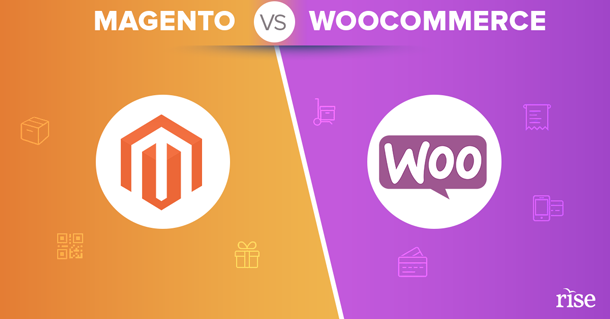

Magento and WooCommerce are the two most popular eCommerce platforms in the market. Both are based on the PHP programming language and offer a wide range of features to develop eCommerce solutions.
They have a few similarities. However, they differ in terms of functionalities. We have compared WooCommerce and Magento in this article. It highlights the best between the two platforms to help you select the right option.
Overview
Magento is a powerful eCommerce platform. It offers free, open-source edition and premium Enterprise edition to build and run online stores. As of 2020, Magento powers 250,000 active eCommerce sites.
WooCommerce is built on WordPress’s top. It enables you to develop complete eCommerce solutions with various customization options. Currently, 3,876,748 websites are using WooCommerce.
Key Features
| Magento | WooCommerce | |
| Themes & Templates | You get a theme-based system with a wide range of extensions. | It supports all WordPress themes. |
| Multi-language Support | It has in-built support for several languages. | You will require a plugin to run sites in multiple languages. |
| Inventory Management | It can handle unlimited products. | It supports unlimited items. |
| Discount & Coupon Code | You get out-of-the-box support to create discounts & import coupon codes. | The basic feature to add, customize coupon codes does not meet every need. |
| Business Support | It is useful for all types of sellers. | It is perfect for small & medium-sized online stores. |
| Security | It offers advanced security & updates to minimize vulnerability threats. | You get basic security features to protect eCommerce stores. |
Ease of Use
Magento has a steep learning curve. It may make you feel a little uncomfortable with it initially. It comes with many in-built features to run online stores efficiently. However, it requires professional users to leverage them at full.
WooCommerce has a simple installation process compared to other eCommerce platforms. Even a newbie can easily set it up and run digital stores with minimum efforts.
Magento Vs. WooCommerce Performance & Speed
A smooth user experience with an excellent loading speed is critical for business success. It does not matter what the online store’s platform and size are.
Both Magento & WooCommerce offer many features. It allows you to optimize product images, increase site-loading speed and provide easy navigation. You can handle other functions easily to improve the user experience.
However, the site performance also depends on the web-hosting provider, the Content Delivery Network (CDN) and many such factors.
Payment Options
There is no much difference between Magento and WooCommerce in terms of payments. Magento supports PayPal, Authorize.net, bank transfer and COD (Cash on Delivery) payment methods by default. You can also use extensions to integrate payment gateways such as Stripe, WePay, Braintree, Google Wallet and more.
WooCommerce supports Stripe and PayPal payment methods by default. You can add other payment gateways using available extensions and add-ons later.
Pros and Cons of Magento
It is a dedicated eCommerce platform with out-of-the-box multistore support. It offers inbuilt SEO features to improve site visibility and rankings. You also get vast community support to solve development & maintenance issues on the go. This option is ideal for handling large online stores due to higher scalability.
However, if you are a beginner, it can be a bit difficult to work with it. Also, the Enterprise edition is expensive compared to other options.
Pros and Cons of WooCommerce
It is easy to set up and use. You get many options to select the right theme as per your needs. Other benefits include low cost of ownership, one of the largest communities of open-source developers and more. It is ideal for businesses selling content like podcasts, eBooks and more.
On the downside, it has less inbuilt features compared to other platforms. Besides, it is not easily scalable to run larger sites.
WooCommerce or Magento
Both stand out due to their strengths & weaknesses. Hence, choosing the right platform depends on the business requirement.
Conclusion
We hope the above comparison helped you understand WooCommerce and Magento better. If you wish to get hands-on experience to develop innovative eCommerce solutions, join our eCommerce web development training course. It will cover the concepts & methods to design, develop, deploy and maintain user-friendly solutions.
We use cookies to deliver the best browsing experience as well as for analytics and marketing purposes. By continuing to browse this website, you accept the use of cookies. For more information, please visit our Privacy Policy